Gmail
Gmail is a free webmail and POP email service, currently in beta
testing, from Google, Inc. It is known as Google Mail in the United
Kingdom and Germany.
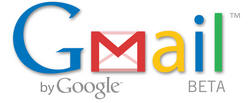
Since Gmail is still in "beta" (having been initially released on April
1, 2004) access to the service is restricted to those who had received an
invitation from an existing account holder, from
Blogger, or through their mobile phone. Some believe Gmail will continue
to be invitation-only even after the beta phase in order to reduce the risk
of spam.
While Gmail is not entirely open to the general public yet, most Gmail users
have many invites to spare, as Google gives most users one hundred free
invitations (and frequently replenishes them, as a reward for users who
frequently check their Gmail accounts). Gmail invites are also given
away at random through Google's home page, and it is also possible to sign
up if one has a U.S. (currently, it also included Australia, Indonesia,
Malaysia, Singapore, Thailand, Turkey, New Zealand and Phillipines)SMS
Signup mobile phone (see Beta testing phase) or a .edu email address from an
accredited U.S. institution. One can find free Gmail invites at various
Web sites, such as the ones shown under External links or even for sale at
online auctions. However, Google has prohibited the sale of Gmail addresses.
The service is notable for providing over 2.6 (and counting) gigabytes (as
of Dec. 24th 2005) of storage space (increased from the original limit of
1.0 gigabyte). This change was announced on April Fool's Day 2005, and was
made for the one-year anniversary of Gmail. The announcement was accompanied
by a statement that Google would continue to increase storage until they
reached the theoretical limit (infinity gigabytes) then give each user one
more. All Google will say about this now is that it will keep increasing by
the second as long as they have enough space on their servers. Gmail makes
intensive use of modern browser features such as JavaScript and keyboard
access keys, allowing for a richer user experience, while retaining the
benefits of a web application (most importantly, immediate availability of
the service on any computer with a supported browser). Gmail also offers
"Basic HTML view" to allow users to access the Gmail messages from almost
any computer running almost any web browser, even old ones (not just
Internet Explorer 5.5+, Opera, Mozilla Application Suite, and Safari).
Recently there has been some criticism about Gmail's information and privacy
policies. Much of it stems from phrases in Gmail's Privacy Policy which
state that Gmail will keep all email for "some time" even if it has been
deleted or the account terminated and that Gmail will disclose personal
information (including the actual text of emails) if it has a "good faith
belief" that such a disclosure is necessary for various reasons such as the
very vague "protect the rights, property or safety of ... the public."
Another unresolved issue discussed amongst privacy advocates is the lack of
disclosed data retention and correlation policies. More than 30 privacy and
civil rights organizations have urged Google to suspend Gmail service until
these issues are resolved .
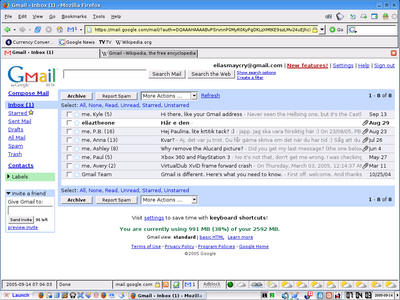
Gmail inbox
The main inbox view, as rendered by the Mozilla Firefox browser in the
Xandros Linux operating system. The Gmail Notifier extension for Firefox
shows when a new message is received or unread. Rather than showing
individual emails, Gmail groups emails into threads, with the number of
messages in each indicated in parenthesis. In this image, the second message
from the top is shown with a white background and bolded text, indicating
that it includes an unread message.
Features
Gmail includes a number of original features as well as improvements upon
those standard to web mail
services.
Conversation views
The main innovation of Gmail is its method of categorizing e-mails, which
Google calls Conversation View. In contrast to other e-mail
services,
Gmail keeps track of individual "conversations" (an original message, along
with all the replies to that message), and allows users to view easily all
the e-mails related to a specific message. Gmail's algorithm for determining
how conversations fit together is not perfect, however: Single conversations
sometimes become fragmented (especially when a replier changes the e-mail's
subject line) and unrelated conversations occasionally become attached
together. Conversations split into two separate storage sections if there
are more than 150 messages, sometimes resulting in 5 or 6 chunks making up a
whole conversation. Another drawback was that the entire conversation gets
deleted if the user deleted one single email which was a part of that
conversation, but this was fixed when a "Trash This Message" button was
added.
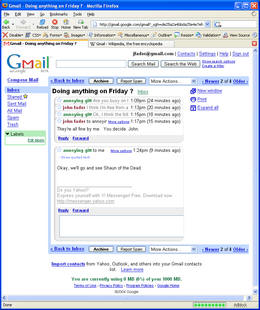
Thread view
A number of messages in the same email thread are shown. The user can
expand and unexpand any message (quickly, using only client-side JavaScript
functionality) to view the content of any number of emails simultaneously
Filtering
Filters can be run only on incoming mail by using an interface similar to
the Search Options dialog (see
searching below). Gmail allows users to
filter messages by their text; their From, To, and Subject fields; and by
whether or not the message has an attachment. Gmail can perform any
combination of the following actions upon a message that meets a label's
criteria: Archiving (i.e. removing the message from the Inbox), marking as
"starred", applying a label, moving to the trash, and forwarding to another
email address.
Two gigabytes of storage
Beginning on April 1, 2005 (Gmail's first birthday), Gmail started to
offer 2 gigabytes of email storage space, which is increasing steadily ever
after. This figure and the original offering of 1000 megabytes are hundreds
of times more than what other webmail
services
offered at the time of Gmail's original announcement in 2004. Google
suggests that users "archive", rather than delete their messages; Gmail's
more than 2 gigabyte of storage is sufficient to hold many years' worth of
an average user's e-mails, and Gmail's search
technology allows users to search their
archives easily. Additionally, users can store files (up to 10 megabytes in
size) as e-mail attachments.
Current storage limit — As of December 28th, 2005, the maximum
storage capacity has already exceeded 2.678801675 GB.
Originally, the rate of increase was one megabyte every 7.44 hours (or 7
hours, 26 minutes and 24 seconds). This means that the storage space
increases approximately 134.4 kilobytes each hour. Recently, however, the
rate of increase has slowed down considerably - it seems that the rate of
increase is now only between 13 and 14 kB per hour.
Auto Save Enhancement
Gmail has added a system of Auto Save, a system for avoiding loss of data
in case of a browser crash or other error. This feature automatically saves
a "draft" copy of the current message once per minute.
Contacts
Gmail automatically saves one's contacts as one sends e-mail. If one
changes, adds, or removes information near an e-mail such as the name while
sending any e-mail, it also updates that in one's contact list.
When one starts typing in the To (or CC or BCC) field it brings up a list
with one's relevant contacts. Experience has shown that this "little Google
search" on one's contacts is not too smart
and it is made only to work with the two main fields of each contact and it
is still restricted to Name and Primary Email. But it does provide a good
and easy interface.
Even because of the auto-completion feature, the auto saving creates a
contact for each e-mail instead of trying to guess which e-mail should be
together and which should be a different contact. That can raise one's
contact list and make it chunky if one keeps more than one e-mail per
person. One can also go to one's Contacts and add more information as one
wishes. They are all basically just for one's note only.
It is possible to import contacts in several different ways, from Outlook,
Eudora, Hotmail, Yahoo!, orkut, and any other
contact list capable of being exported as a CSV file. It does allow one to
export one's contacts to CSV as well.
It is also possible to group contacts in a similar way as e-mails are
labeled.
Interface
The user is composing a new email, and has invoked the client-side spell
checker feature. Like the spell checker in a word processor, the user is
shown words which are not recognized, and can either pick a replacement from
a list or manually enter an alteration. In addition, Gmail's spell checker
has limited non-English language support; it can detect one's message's
language and spell-check in that language. Some ideograph-based languages
like Chinese are not supported.
Gmail's interface relies heavily upon JavaScript, a client-side scripting
programming language, which requests data from the Gmail servers via
XMLHttpRequest, an example of the web-development technique which some
referred to as Ajax. Since much processing takes place on the user's
computer, relatively little information must be transferred between Gmail's
web servers and the client, so the interface should run quickly, even over a
dial-up connection.
In late February 2005, Google rolled out a "basic HTML view" Gmail
interface, accessible from any HTTP 1.1-compliant web browser (previously,
Gmail was only accessible via a few modern browsers
in "standard view"). The HTML interface does not use JavaScript, and is much
slower than the standard interface.
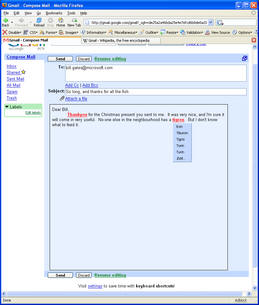
Compose view, with spell checker
The user is composing a new email, and has invoked the client-side spell
checker feature. Like the spell checker in a word processor, the user is
shown words which are not recognized, and can either pick a replacement from
a list or manually enter an alteration. In addition, Gmail's spell checker
has limited non-English language support; it can detect one's message's
language and spell-check in that language. Some ideograph-based languages
like Chinese are not supported.
Keyboard shortcuts
Gmail allows users to navigate its interface by using the keyboard as an
alternative to the mouse, which is the norm for site navigation. This
feature is not enabled by default, although instructions on how to enable it
are provided.
Labels instead of folders
Gmail allows users to categorize their e-mails with "labels." Labels give
users a flexible method of categorizing e-mails, since an e-mail may have
any number of labels (in contrast to a system in which an e-mail may belong
to only one folder). Users can display all e-mails having a particular label
and can use labels as a search criterion.
Gmail also allows users to set up filters which label incoming e-mail
automatically.
Users can simulate the functionality of folder-based filtering by applying
labels and archiving mail as it arrives.
Gmail allows users to search by a number
of criteria:
- whether the message "has" or "does not have" a certain phrase
- the message's From, To, and Subject fields
- the message's location (All Mail, Inbox, Starred, Sent Mail, Spam,
Trash, All & Spam & Trash, Read Mail, Unread Mail, or a label)
- whether the message has an attachment
- the message's date within a given range (e.g. all messages received
within one week of January 1, 2004)
Gmail also allows users to construct advanced
search strings. For example, the following
search strings would search for all e-mails
from Bob to anyone with the subject field containing "work" or "school" but
not "close friend", labeled as "to do" or "pending" among all that are not
in "Inbox" (which means it is archived), with a PDF attachment, and with a
carbon copy to self, limited to the date range between May 1, 2004 and June
1, 2004, that are not starred:
from:bob subject: (work OR school -{close friend}) (label:(-inbox)
in:to-do OR label:pending) has:attachment filename:pdf in:unstarred
cc:self after:2004/05/01 before:2004/06/01
from:bob subject: (work OR school -{close friend}) (label:to-do OR
in:(pending)) -(in:inbox) has:attachment filename:pdf in:unstarred
cc:self after:2004-05-01 before:2004-06-01
(Note that logical operators (e.g. OR, AND) must be in upper-case)
(Also note that field operators cannot contain blank values ([buggy]
unless it is the operator in the string))
([buggy] Using labels that contains space(s) within the label will only
work with that label alone, probably due to the "labels hyphenation")
([buggy] Excluding Inbox from searches seems to not work properly)
See also: How do I use Gmail's advanced
search?
Spam filtering
Gmail offers a spam filtering system. Independent tests conducted in May
2004 showed this spam filter to be about 60% accurate for a wide variety of
spam, significantly lower than the spam filtering accuracy of Yahoo! Mail
and Hotmail. In December 2004, however, unscientific tests suggested that
Gmail's accuracy was much higher than it was in May. Messages marked as spam
are automatically deleted after 30 days.
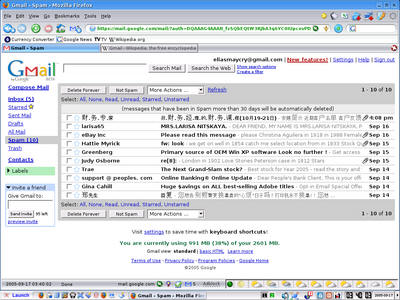
Gmail's spambox
Email signing
Gmail is the first major provider to sign outgoing mails with Yahoo!'s
DomainKeys signatures.
POP3 access
Although not offered with the original release, Gmail allows all users to
send and receive their e-mail via POP3 (over SSL) and SMTP. Some users have
experienced authentication difficulties when trying to gain access to their
accounts and have blamed Google for the problem, however the authentication
problem is likely due to the user needing to activate a setting within Gmail
before it will allow POP access, not because Gmail has a technical problem.
However, some users continue to experience authentication problems in spite
of the activation of this setting.
Rich Text Formatting
A feature added to Gmail on its first birthday, Rich Text Formatting,
allows users to set the size, font, color, and alignment of text, create
bullet points and numbered lists, in addition to several other features.
With Rich Text Formatting enabled, messages to which one replies and
forwards retain all embedded formatting, whereas Plain Text editing strips
out all formatting including embedded graphics.
Rich Text Formatting is currently only able to work on browsers that support
WYSIWYG, such as Mozilla Firefox and Internet Explorer. Browsers that do not
support WYSIWYG editing cannot take advantage of this feature.
Username handling
Gmail usernames must be between 6 and 30 characters (inclusive) and made
up of only letters, numbers, and periods (.). Experimentation has shown that
Gmail ignores periods when resolving addresses. That is, the account
google@gmail.com receives mail sent to goo.gle@gmail.com,
g.o.o.g.l.e@gmail.com, etc. Likewise, the account goo.gle@gmail.com receives
mail from google@gmail.com. However, when signing in it is necessary to
include periods.
Gmail blocks users from creating addresses that vary by periods only.
Consider two different people with the addresses john.doe@gmail.com and
johndoe@gmail.com, who will each receive all emails intended for either one
of the accounts.
Plus-addressing
Gmail also supports "plus-addressing" of emails. Messages can be sent to
addresses in the form: gmail.user+extratext@gmail.com where extratext can be
any string. Plus-addressing allows users to sign up for different
services with
different aliases and then easily filter all e-mails from those
services. It
does not appear, however, that the +string feature works when sending email
from a Gmail account to itself. Additionally (in some cases) the string
appended to the e-mail address may not be longer than six characters.
Gmail Notifier
The Gmail Notifier, an official tool offered by Google, displays a small
icon in the notification area (see Taskbar) in Microsoft Windows and on the
right-hand side of the menu bar in Mac OS X, indicating the presence of new
mail in one's inbox. It also has a feature that makes Gmail the default mail
client for mailto links. It does not, however, download new messages.
On Windows, the Gmail Notifier is uninstalled (after a prompt to the user)
if one installs Google Talk, which provides
the same features and a new, updated interface.
Available to those who surf with Mozilla Firefox is the identically named
Gmail Notifier extension, first appeared around July 8, 2004 , which is
more than one month before the official one (August 21, 2004).

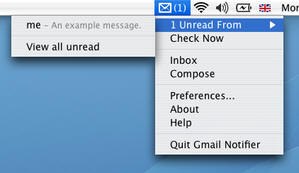
Multi language support
The Gmail interface currently supports 38 languages: Brazilian
Portuguese, Bulgarian, Catalan, Chinese (simplified), Chinese (traditional),
Croatian, Czech, Danish, Dutch, English (UK), English (US), Estonian,
Finnish, French, German, Greek, Hindi, Hungarian, Icelandic, Indonesian,
Italian, Japanese, Korean, Latvian, Lithuanian, Polish, Romanian, Russian,
Serbian, Slovak, Slovenian, Spanish, Swedish, Tagalog, Thai, Turkish,
Ukrainian and Vietnamese.
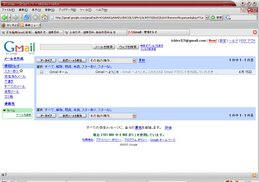
Gmail supports 38 languages. Here, its interface is shown in Japanese.
RSS feeds
After its one-year anniversary, Gmail started placing customizable RSS
feeds in some interfaces. The RSS feeds are limited to a single line at the
top of the page, which can be scrolled through by the user. The option now
appears in all accounts as "Web Clips".
Dormant accounts
Every account which is inactive for 9 months gets deactivated by Gmail.
All stored messages get deleted and the account gets "recycled", which means
the account name can be used by any other users afterwards. Other webmail
services, like Yahoo! and Hotmail, have different, sometimes shorter, times
for marking an account as inactive.
Anti-virus scanning
Gmail recently introduced a feature which automatically scans all
incoming and outgoing email attachments for viruses. If a virus is found on
an attachment the reader is trying to open Gmail will try to remove the
virus and open the newly cleaned attachment. Gmail also scans all outgoing
attachments, and if a virus is found on an outgoing attachment Gmail will
prevent the message from being sent until the attachment is removed; this is
an innovation that has not been previously seen in other webmail services
such as Hotmail or Yahoo. Despite of the newly added anti-virus service,
.exe, .zip, .com and a few other files are still blocked. This makes it
difficult to use Gmail to send
programs to
other users. A way users bypass this is to change the file extention to .txt
then change it back once the other user has retrieved the file.
Limitations
The conversation view groups related messages in a linear stack, which
can be expanded and collapsed. While this does provide an innovative view of
an email thread, it does not provide any way to differentiate messages that
branch off from the original thread. This can occur when mail is sent to
multiple recipients who respond individually.
Google seems hesitant to release any upcoming plans for the implementation
of these features.
Absent Features
The following features are absent from Gmail.
Some are provided by another kind of computer program, such as
Eudora, Outlook Express or Apple Mail.
Some are provided by same kind of computer program, webmail
applications (sometimes for a price), such as Yahoo! Mail and Hotmail.
Features present in Linux mail programs (such as Kmail) are: automatic
spell-checking (by red underline), "attachment warning," and automatic
bounce-back of unwanted mail (imitating a mail-daemon message). Gmail may or
may not add these in the future.
General
Those are absent features that includes, at least, Organizing and
Searching:
- The ability to fully use Google search
technology on Gmail.
- The ability to fully use Google search
technology on Gmail Contacts.
- The ability to search (or filter)
in the whole e-mail, like in the headers.
Organizing
- The ability to group labels.
- Some conversation handling features such as adding an e-mail to a
conversation and removing one from it.
- The ability to select "All" e-mails, or "All" contacts, or even
apply labels to all selected e-mails, not only the limited amount
displayed. (this is in fact a much bigger limitation than it may look
like as using both features together can get really troublesome)
- The ability to use the automatic filter on outgoing messages or
messages already received. (although users can use Gmail's advanced
search to filter messages already
received)
- The ability to do many actions with the same filter (although the
user can always create a lot of filters).
- The ability to search within text
message attachments.
- The ability to use Boolean criteria for filters or any kind of
searching.
- The ability to go to the oldest item, or page, of any
search / filter / label, whenever the
list gets big enough.
- The ability to choose how many items a
search should return per page (the settings / max page size only
works for labels).
- The ability to use same searching
syntax with filters.
(E-mail) Protocol Resources
- The ability to import mail from external POP3 servers into the
webmail account.
- The ability to queue messages to be sent automatically at a future
chosen date and time.
- The ability to send a request for a return receipt with messages.
- The ability to mark the importance (e.g., "urgent") of a particular
message.
- IMAP support (few webmails do have it, although Fastmail.fm has such
a feature).
Others
- The ability to delete any attachment from a delivered message, be it
sent or received.
- The ability to change signatures along with changing the "From"
field.
- The ability to log in on the same account and mailbox by using
Plus-addressing while enabling to customize configurations.
- An option to add description / information to Report Spam feature.
Differences between Interfaces
It has been noted that changing the interface language between
English(UK) and English(US) will affect the overall interface. For example,
the UK has different standards for date and time, as well as naming (ie:
Trash versus Deleted Items).
While these are simple cosmetic differences, there are several limitations
encountered within various language interfaces:
Non-US Interfaces
Because Google is located primarily in the United States, non-US
interfaces tend to lag behind in upgrades and features:
- Use of the Custom From Address feature is disabled. Custom From
Address on Gmail Help (2005-11-29)
- Web Clips (RSS/Atom Feeds) are disabled.
- Virus scanning feature is unavailable.
US Interface
- When replying, the display does not show the original message's
time, just the date.
Bugs
- If the text of the subject is too long, labels are overlapped and
blocked by tool icons on the right side of the interface.
Development
Gmail was announced amid a flurry of rumor. Owing to April Fool's Day,
however, the company's press release was greeted with skepticism in the
technology world, especially since Google already had been known to make
April Fool's Jokes (such as PigeonRank). However, they explained that their
real joke had been a press release saying that they would take offshoring to
the extreme by putting employees in a "Google Copernicus Center" on the
Moon. Jonathan Rosenberg, Google's vice-president of products, was quoted by
BBC News as saying, "We are very serious about Gmail."
Gmail also initially received a lot of criticism for a statement they made
in their original terms of use, refusing to guarantee that all e-mails at
Gmail would be deleted upon request by the user. Google later clarified that
they were referring to backup copies of emails, and promised that all
deleted mails would eventually be expunged completely from their servers.
This, along with the feature that advertisements would be generated by
software-based scanning of e-mails in order to better target them, gave rise
to a controversy on web privacy (see BBC News Article and google-watch.org;
for a defense see The Fuss About Gmail and Privacy: Nine Reasons Why It's
Bogus).
Before being acquired by Google, the gmail.com domain name was used by the
free email service offered by Garfield.com, online home of the comic strip
Garfield. This free email service has moved to e-garfield.com.
As of June 22, 2005, the Gmail IRI has been changed to
http://mail.google.com/mail/ instead of
http://gmail.google.com/gmail/.
Beta testing phase
Google initially invited about 1,000 employees, friends, and family
members to become beta testers, with trials beginning on March 21, 2004.
Active users from the Blogger.com community were
offered the chance to participate in the beta-testing on April 25, and
later, Gmail members occasionally received "invites" which they could extend
to their friends. One round of invites was sent out on May 1, and another
three invitations were given to all active members on June 1; by mid-June,
the number of invitations had increased, with many users receiving between
three and five invites daily. On February 2, 2005, the invitation interface
was changed to make it easier to give invites by simply entering an email
address and at approximately 3:00 UTC on February 3, 2005, some Gmail users
were awarded 50 invites, suggesting that Gmail would soon go public. Now, if
one attends a Google Mini webinar, one will
get a Gmail invitation. Go to
http://www.google.com/enterprise/mini/product_tours_demos.html for more
information.
During the initial months of the Gmail beta, Gmail's well-publicized feature
set and the exclusive nature of the accounts caused the aftermarket price of
Gmail invitations to skyrocket. According to PC World magazine, Gmail
invitations were selling on eBay for as much as US$150, with some specific
accounts being sold for several thousand dollars. After a new round of
invitations in early June, the price for invitations fell down to between
US$2-$5. Several philanthropic Gmail users have utilized
services such
as the now defunct GmailSwap to donate invitations to people who want them.
On June 28, Google amended its policy to forbid the selling of registered
accounts. See the Official Gmail Program Policy.
History
In March 2004, Google said that Gmail would probably be released publicly
after six months of testing, which would have placed their launch in
September 2004, but it was still in beta as of December 2005. Speculation
also regarding the release date is right after The New York Times said they
had "credible sources" saying "Gmail will be released publicly by the end of
the year." As of present, however, one needs an invitation from an existing
user or to sign up via text message using the gmail homepage (www.gmail.com)
and a U.S. cellular phone that has SMS
capabilities to get an account, and the site still says it is in the beta
development stage. The number of invitations existing account holders can
send has been varied, presumably to control the usage and growth of the
system. For all intents and purposes, Gmail is essentially open to the
public now, since thousands of invites are publicly available from many
public websites. The use of the invitation/text message system helps prevent
spammers from registering numerous accounts for purposes of spamming, and
will ensure that any account used illegally will have another valid email
address or phone number to trace a user (the one to which the invite was
sent).
In January 2005, security experts discovered a critical flaw in the handling
of Gmail messages that would allow hackers to easily access private e-mails
from any Gmail user's account. This was posted with detailed information to
popular technology site Slashdot at 9:23 a.m. PST on January 12, 2005. At
roughly 10:15 a.m. PST on January 13, 2005, developers at Gmail announced
that they had fixed the problem, and that the security flaw had been
patched. Despite Gmail's status as a beta application, this raised concerns
among some users who use Gmail as their primary mail account.
On April 1, 2005, exactly one year after the initial release, Gmail
increased the mailbox size to 2 GB (advertising it as 2GB plus) and
introduced some other new features, including formatted editing (giving
users the option of sending messages in HTML or plain text). As of December
2005, the mailbox size is 2.60 GB, and is increasing continuously at a rate
of approximately 10 MB per month.
The "New! Get Gmail - Google's free email service with over 2GB of storage."
promo that appears for a few days on some computers.
On June 7, 2005, Isnoop.net Gmail Invite Spooler was deactivated by the site
moderator, due to intolerance by Google. It was explained that Gmail's
Product Manager would no longer tolerate the service, and was shut down
midnight PDT. The service was featured in Popular Science magazine, and had
given out over 1.2 million gmail accounts.
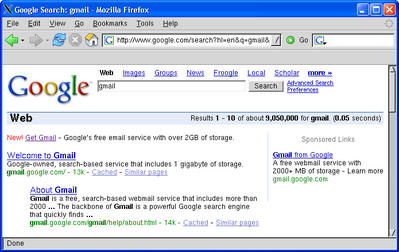
The "New! Get Gmail - Google's free email service with over 2GB of
storage." promo that appears for a few days on some computers.
Since July 11, 2005, or more likely earlier, Google has been giving away
free Gmail accounts to random people who search
for the word "gmail" using the Google search
engine. Follow this link and look at the top of the page for the promo
that says "New! Get Gmail - Google's free email service with over 2GB of
storage." However, this promo may only last a few days for a particular IP
address, before it does not show up any more. ^
On August 24, 2005, Google offered a new method of signing up for a Gmail
account via mobile phone text messaging. The public would be able to obtain
an account by submitting a U.S. mobile phone number to Google, which would
then send a text message with an invitation code that would be used to
create a Gmail account. Numbers are stored in order to keep track of the
number of accounts created which is limited to ten per phone number. This
method of creating accounts makes it difficult for spammers to send out spam
messages, getting spam delivered, or obtaining an account thus keeping Gmail
as spam-free as possible. This method is currently only available to people
with a U.S. mobile phone number. See
https://www.google.com/accounts/SmsMailSignup1.
This shows the option to choose which address a message appears to be sent
from.
On August 30, 2005, Gmail started to add the facility to customise the
address that messages are sent from on outgoing mail to some accounts. This
adds option for outgoing messages to appear as if they had been sent from an
alternative email address, rather than from the Gmail account. Right now,
this option is only available for accounts that have set English (US) as
Gmail display language. Gmail Help Center., but users can switch to another
language and keep using this feature after adding another address.
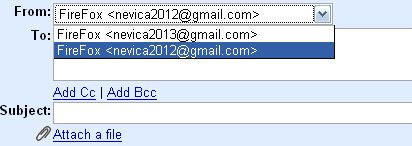
This shows the option to choose which address a message appears to be
sent from.
In August 2005, Gmail started offering 100 invites to some users.
In October 2005, Gmail withdrew use of username@gmail.com within the UK, due
to a dispute with the UK company Independent International Investment
Research (IIIR), who own the gmail.co.uk domain. From October 19th, any new
UK users wanting a gmail account were forced to have
username@googlemail.com. There is still a concern that old UK users will
also have to change to the new domain sometime in the future.
Non-English languages
- On April 13, 2005, Gmail became available in several languages:
British English, Dutch, French, German, Italian, Japanese, Korean,
Portuguese, Spanish, Russian and simplified and traditional Chinese.
- On June 30, 2005, Gmail became available in 4 new languages: Danish,
Finnish, Polish, and Swedish.
- On August 9, 2005, Gmail became available in 12 new languages:
Bulgarian, Croatian, Greek, Hungarian, Icelandic, Indonesian, Latvian,
Serbian, Slovak, Slovenian, Ukrainian, and Vietnamese.
- In the beginning of September 2005, Gmail became available in 9 new
languages: Catalan, Czech, Estonian, Hindi, Lithuanian, Romanian,
Tagalog, Thai, and Turkish.
"Lockdown in sector 4"
In 2005, some Gmail users began reporting that their accounts were being
locked for 24 hours or more. Account home pages were reportedly replaced
with the flippant title: "Lockdown in sector 4!" along with a short
explanation of the lockdown. Google's explanation was that the accounts in
question had conducted "unusual usage," although the users maintain their
innocence. Most account lockdowns are lifted after 24-72 hours, although
some users report being locked out again not long after , though most of
the time the user could clear their cache and reload the page, and the
account would become unlocked again. It also may be worth noting that
virtually all webmail providers will suspend an account if it is suspected
of violating the provider's terms of service.
It is worth noting that many scripts for the Mozilla Firefox extension
Greasemonkey have caused this problem as well.
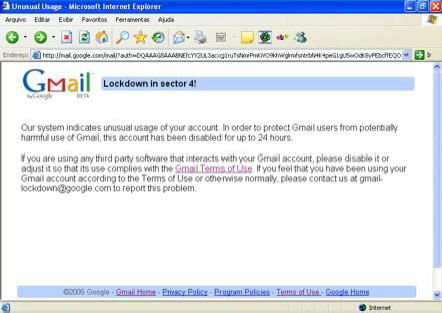
Competition
After Gmail's initial announcement and development, many existing web
mail services
quickly increased their storage capacity. For example, Hotmail went from
giving some users 2MB to 25MB (250MB after 30 days), while Yahoo! went from
4MB to 100MB. Yahoo storage upgraded again in late April 2005, to 1GB. These
were all seen as moves to stop existing users from switching to Gmail, and
to capitalize on the newly rekindled public interest in web mail
services. The
desire to catch up was especially visible for Microsoft's Hotmail, which
upgraded its email storage erratically from 250 MB to the new Windows Live
Mail (beta) which includes 2 GB of storage over a number of months. In
August 2005, AOL started providing all AIM screen names with their own email
accounts with 2 GB of storage.
Name change
The German version of Gmail was first known as Gmail Deutschland.
However, the company Giersch Ventures already had the words G-mail
trademarked since 2001, and filed a lawsuit against Google for trademark
infringement. Gmail is a postal mail service around Hamburg.
On 4 July 2005, Google announced that Gmail Deutschland would be renamed
Google Mail and that every German IP would be forwarded to a different
server where every new user would be able to obtain an address in the
googlemail.com domain. Any German user who now wants a gmail.com address
must sign up for an account through a proxy. German users who were already
registered were allowed to keep their old gmail.com addresses.
However, also new users in Germany are reachable at gmail.com, the emails
are forwarded. If using some Google
services like
Google analytics or
Google alerts the German users still see
their gmail address, even if they registered recently at googlemail. As it
seems Google does not pay much attention to the German trademark so far,
maybe because the Giersch business homepage looks very strange somehow. For
example it is difficult to find out what exactly the
services of
Gmail Germany are, but there are many words about innovative
services and
there is some Google Adsense advertising on the
website. Also, a new service about transforming postal mail into email and
being payed for receiving letters, one eurocent for each one, is described,
but only offered for a very small area so far. There is talk about
Europe-wide expanding anyway. This leads to the question: Will the German
trademark Gmail be expanded to an EU trademark ? This still would be
possible, for some bigger money sum to be payed to the trademark office.
Another question is why Google didnīt check that out in the past. It had
been possible for less than 100 Euros.
In practice, there is little difference between the two, as googlemail.com
addresses act as aliases for their gmail.com counterparts. A user interested
in having all of his or her mail sent to a gmail.com address only needs to
change the reply-to address in the account settings page.
The Giersch Ventures lawsuit also forced Google to change the site's URL
from gmail.google.com to mail.google.com, which briefly broke some
applications and plugins that relied on it to access Gmail.
Gmail in the UK
On 19 October 2005, the UK version of Gmail was converted to Google Mail
for similar reasons to those described above for Germany .

The Google Mail logo
Privacy
There has been a great deal of criticism regarding Gmail's privacy
policy. Some of the controversy surrounded the clause "residual copies of
email may remain on our systems for some time, even after you have deleted
messages from your mailbox or after the termination of your account." Many
believed that this meant that Google would intentionally archive copies of
deleted mail forever. Google continues to refute some of this criticism by
pointing out that Gmail is using mostly industry wide practices. Google
later stated that they will "make reasonable efforts to remove deleted
information from our systems as quickly as is practical."
Most of the criticism, however, was against Google's plans to add
context-sensitive advertisements to e-mails by automatically scanning them.
Privacy advocates raised concerns that the plan involved scanning their
personal, assumed private, e-mails, and that this was a security problem.
Allowing e-mail content to be read, even by a computer, for advertising
purposes, raises the risk that the constitutional expectation of privacy in
e-mail will be reduced. Furthermore, non-subscribers' e-mail is scanned by
Gmail as well, and these senders of e-mail did not agree to Gmail's terms of
service or privacy policy. Exacerbating the situation is the fact that
Google can change its privacy policy unilaterally, and that Google is
technically able to cross-reference cookies across its information-rich
product line to make dossiers on individuals.
Opponents of these views state that when one's e-mail is checked to see if
it is spam, it is being scanned by the same process. Because a human is not
reading the message, they say, it is not a problem.
Another unresolved issue discussed amongst privacy advocates is the lack of
disclosed data retention and correlation policies. More than 30 privacy and
civil rights organizations have urged Google to suspend Gmail service until
these issues are resolved .
See also
Add-Ins
Other email Providers
- 30Gigs.com (actually ~600 MB)
- AIM Mail (2 GB)
- Hotmail (250 MB; 2 GB paid-subscription)
- Yahoo! Mail (1 GB)
External links
Gmail tools
-
PhpGmailDrive by Rahat Ayub -A Popular freeware Gmail based online
Storage system compliant to GmailFS.
-
Gmail Bookmark - GMail Bookmark manages one's bookmarks and uses
your Google GMail account as a storage.
-
Gmail Notifier - Official Gmail Notifier program. Sits in system
tray and checks email, shows snippets, and associates mailto: links
(BETA).
-
Gmail tools and plugins
-
How to use Gmail as a second brain - Article on how to use Gmail for
data and information storage and management.
-
GetByMail - Remote access and file sharing by mail software. 100%
compatible with Gmail.
-
G-Mailto - Associate mailto: email links on the web with Gmail.
-
gDrive a PHP script to use gmail to store large files. major benefit
being that users of all operating systems can access it.
-
WebMailCompose - Mozilla Extension to associate mailto: email links
with GMail (among other webmail services.)
-
Google Mail Loader - Helps import one's existing email into Gmail.
-
gExodus - Another tool to import existing email into Gmail.
-
GTransfer - Service that transfers e-mails from other webmail
services to Gmail
-
libgmail is a
Python
API for writing programs that use Gmail
-
Gmail S/MIME is a Firefox extension bringing
S/MIME
encryption to Gmail.
-
GmailFS provides a
mountable
Linux
filesystem using
libgmail and
FUSE
-
Gmail Drive provides a
mountable
Win32
filesystem using MS Windows
-
GmailHost provides an additional front-end for Gmail Drive that
allows one's files to be accessed online
-
RoamDrive Standalone Windows application that can use GMail (as well
as Hotmail and MSN) as a storage device.
-
GTray - A simple Gmail notification tool.
-
Gmail Agent API - Mail-notifier & address-importer.
-
GetMail - Forward one's Hotmail or MSN emails to one's Gmail
account.
-
Mail::Webmail::Gmail - Perl module interface to Gmail.
-
GMNotifier - An unofficial Gmail Notifier program written in the
.NET framework
-
GMail API for Java(g4j) - A
Java-based
API for Gmail.
-
GmailStatus GMail Notifier program for Mac OS X 10.3.x
-
Goollery - Gmail-based photo gallery, allowing one to upload
pictures from a website; the pictures are automatically stored in one's
gmail account. Its not working as of 29 October 2005.
-
GMail Wireless - Allows one access to one's Gmail account using a
wireless WAP phone
-
KCheckGmail - GMail Notifier program for KDE 3.x
-
GmailerXP - Allows for full control of Gmail accounts in windows.
(Contact management, Labels, message browsing, etc.)
-
Bypass Gmail Antivirus Scan - Send file attachments of any type
(exe, dll, etc) with GMail
-
Gmail Spooler - Give them your email and recieve a Gmail invite.
FAQs
Blogs
|